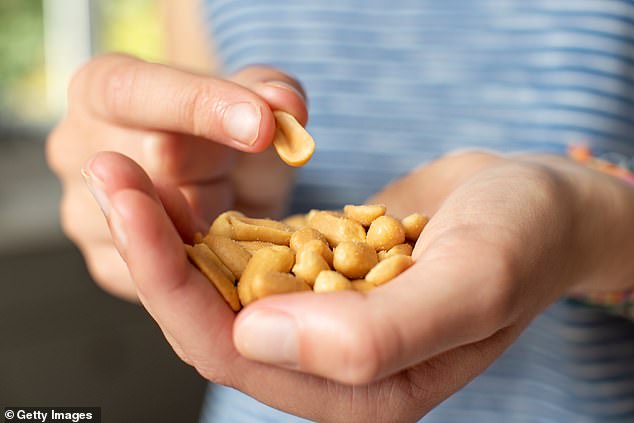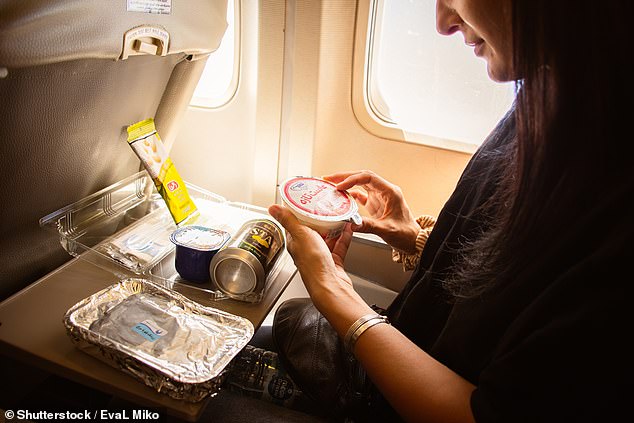It’s a belief that’s got the popular snack banned from many airlines.
But it turns out there is no evidence nut allergens can spread through aircraft ventilation systems, a scientific review has found.
Announcements requesting passengers not to consume nuts during flights are unlikely to reduce the risk of in-flight reactions and might provide false reassurance, they found.
Instead, residue left on surfaces — such as tray tables and seat back video screens — pose the biggest risk to those passengers.
This risk is heightened by the quick turnarounds of budget airlines but could be mitigated by a quick wipedown, they suggest, with anyone with nut allergies be allowed to board early.

Even then, allergic reactions to food are up to 100 times less likely to happen during flights than they are ‘on the ground’, although this could be from passengers taking precautions.
Food allergy is the most common cause of anaphylaxis, a potentially life-threatening allergic reaction.
It is estimated around 2–3 per cent of children and 1–2 per cent of adults in the UK have a food allergy.
Researchers from Imperial College London carried out a systematic review of published evidence dating back to 1980 on behalf of the UK’s Civil Aviation Authority (CAA).
While peanut allergens can be detected at very low levels in the air when shelling nuts, the dust settles quickly and very little dust circulates in the air.
Cabin ventilation systems are designed to circulate air across the aircraft, rather than along the cabin, so minimise the potential for spreading passenger-generated contaminants through the cabin, the authors said.

Air is completely exchanged every three to four minutes during a flight compared with every 10 minutes for hospitals and classrooms.
In modern commercial aircraft, around half of the air intake is recirculated air that has passed through particulate air filters which effectively remove dust, vapours, microbes, and capture aerosolised food particles at the same time.
The other half comes from outside, the authors explain, with allergic reactions to aerosolised foods rare.
Food proteins are often ‘sticky’ and any unintentional exposure likely stems from surface contamination, according to the findings published in the Archives of Disease in Childhood.
This can be transferred from the hands either to food being eaten or directly to the mouth or face.
Cleaning these surfaces at the start of a flight with sanitising wipes will minimise this risk, and is ‘particularly important, given the minimal cabin cleaning which often occurs in between flights, especially with low-cost carriers.’
Paul Turner, a clinical professor in anaphylaxis, paediatric allergy & clinical Immunity, at Imperial College London, who led the research said the findings should reassure passengers.
He said: ‘People shouldn’t be worried about what food is being transmitted in the air when they fly.
‘We didn’t find any evidence that nut particles could travel through the cabin ventilation system on airplanes and cause reactions.’
He added: ‘The one thing people must do to protect themselves is to clean their seat area.
‘If food-allergic people can board first and have time to clean their seat area with something like a baby wipe or antibacterial wipe, they are much less likely to have accidental reactions.’
Researchers suggest those at risk should carry adrenaline auto-injectors, such as an EpiPen in their hand luggage, as these are not always included in onboard medical kits.
The report is being presented to major airlines, patient groups and anaphylaxis charities in a bid to get consistent policy across airlines operating out of the UK and internationally ‘to reflect what the evidence is and really make a difference to food-allergic passengers.’
Simon Williams, chief executive of Anaphylaxis UK, said: ‘A key take-home message is the importance of passengers cleaning their seat area, including the tray table and the seat-back entertainment system.’

